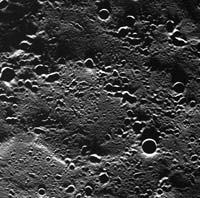|
COMETS EARTH JUPITER KUIPER BELT MARS MERCURY METEORITES NEPTUNE OORT CLOUD PLUTO SATURN SOLAR SYSTEM SPACE SUN URANUS VENUS ORDER PRINTS
PHOTO CATEGORIES SCIENCEVIEWS AMERICAN INDIAN AMPHIBIANS BIRDS BUGS FINE ART FOSSILS THE ISLANDS HISTORICAL PHOTOS MAMMALS OTHER PARKS PLANTS RELIGIOUS REPTILES SCIENCEVIEWS PRINTS
|
Related Documents
Download Options
Date acquired: March 29, 2011 Of Interest: This WAC image showing a never-before-imaged area of Mercuryís surface was taken from an altitude of ~450 km (280 miles) above the planet during the spacecraftís first orbit with the camera in operation. The area is covered in secondary craters made by an impact outside of the field of view. Some of the secondary craters are oriented in chain-like formations. This image was taken during MESSENGERís closest approach to the sunlit portion of the surface during this orbit, just before crossing over the terminator. The oblique illumination by the Sun causes the long shadows and accentuates topography. The highly elliptical orbit of MESSENGER brings the spacecraft down to a periapsis (MESSENGERís closest approach to Mercury) altitude of ~200 km (125 miles) and out to an apoapsis (MESSENGERís farthest distance from Mercury) altitude of ~15,000 km (9300 miles). On March 17, 2011 (March 18, 2011, UTC), MESSENGER became the first spacecraft ever to orbit the planet Mercury. The mission is currently in its commissioning phase, during which spacecraft and instrument performance are verified through a series of specially designed checkout activities. In the course of the one-year primary mission, the spacecraft's seven scientific instruments and radio science investigation will unravel the history and evolution of the Solar System's innermost planet. Credit: NASA/Johns Hopkins University Applied Physics Laboratory/Carnegie Institution of Washington |
